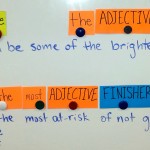Did you know that the majority of English learners in U.S. K-12 schools are not immigrants? From outside of the ELD classroom, it’s easy to see the group as rather monolithic in their needs, despite their cultural and linguistic diversity. At a glance, one might assume that these students need direct instruction in the English Language, with an increasing level of complexity, until they are proficient for someone their age. In reality, providing students with language acquisition instruction is not a simple linear scaffold up to grade level reading, writing, listening and speaking. A growing body of research and commentary demonstrates the diverse needs of English Learners, and the idea that a one-size-fits-all approach could be the reason that so few EL’s reclassify as proficient each year in so many states, including Arizona.
This is just one more reason I am glad that Arizona is shifting its policy toward more flexibility for districts in providing language acquisition services for English learners. The needs of newcomers are very different than those of students who are often placed in an introduction level ELD class, but who have been here longer and have acquired some English. For example, teaching the alphabet may seem like a waste of time for these students. In fact, it is a waste of time. Yet, that may be exactly what a newcomer who speaks and reads Arabic needs.
I suppose a lot of this is the same as in a normal classroom, where our students also have diverse needs. The difference is that EL’s have such a gap to make up, and the pressure to quickly close that gap is almost tangible. In our Arizona school letter grade assessment, for example. the state examines the passing rate for AZELLA (how many students become proficient and are taken out of ELD services.), and also how many students go up to higher levels each year. The pressure to move the EL’s along is very real.
One population that has fascinated (and often frustrated) me since I began teaching ELD five years ago has been the intermediate level students. Many of them are what is termed “LTELL’s”, long term English language learners. This is the group where you often find the students who were born in the United States, but speak Spanish (or another language) at home, and have been in ELD since they were in kindergarten or first grade. I teach 7th grade. Shouldn’t they be able to pass this test by now? That’s the question that arises all the time in conversations with other teachers. Most sources cite 3-5 years as the length of time needed for an EL to become conversationally proficient, with a bit longer required to acquire fluent academic language, up to about 7 years. We are going on eight years in my class, for many.
It is indeed baffling. Many of them have spent far too long together in elementary school, and it shows in their behavior, but that still doesn’t explain why they haven’t made more progress.
Often people will mention the low incomes, or low education level of the parents at home. However, many of these kids have the same types of home life as large parts of our general population at school. Many play after school sports (soccer, boxing, even taekwondo are some of the favorites of my current students). Most of the parents express the importance of school to these students’ futures and hold them accountable for their behaviors and academic choices at home when I am able to contact them. Sure, many of my students have challenges at home, but that is not much different than other students at our Title I school.
So, did they not care about the test? Are they dyslexic or do they have some other types of undiagnosed learning disability? Are they really that much lower than some of our lowest readers who are NOT classified as Englsih learners? These are questions we ask when we talk about this group of students.
Research sheds some light onto the issue, though doesn’t seem to hold a lot of instant fixes. In reviewing some articles for this blog, I came across a journal article by Marcus Artigliere reviewing the research on long term English language learners. One thing that caught my eye was information about the affective domains of LTELL’s, in other words, the way the students felt about school. In a 2014 study, Kim and Garcia found that LTELL’s had a generally positive outlook on their education, with the perception that they were active learners, confident, self-motivated, and able to self-advocate in order to succeed academically. This was contrasted with their quite low academic performance.
I find this contrast fascinating. On the one hand here is this confident, happy-go-lucky group of kids who feel like they are actively involved in their learning. And yet on the other hand they are clearly not learning fast enough given the sheer volume of English instruction they have received throughout the past 7-8 years, starting when they were very young.
At least in my school, very few pass AZELLA and reclassify as proficient each year, which means all but a handful will pass on into high school still classified as English Learners. My understanding is that this is not uncommon across the state. I feel desperate to change this, yet the trend has persisted each year.
This pattern points to the need to consider subgroups of English learners as we design our ELD programs in this new era. We need to think about how our systems, structures and support meet these students where they are and, ideally, launch them out of ELD and into their best chance to graduate high school on time and take courses which will ignite their interests and create a path to college and career afterward.
Work Cited
Artigliere, Marcus. “The Proficiency, Instructional and Affective Domains of Long Term English Language Learners: A Review of the Research.” TESL-EJ, vol. 23, no. 1, May 2019, pp. 1–19. EBSCOhost, search.ebscohost.com/login.aspx?direct=true&db=ehh&AN=136397227&site=ehost-live.









Comments 1
I have to be completely honest, I SO look forward to your blogs. The way you communicate passion, advocacy, and the true depth and breadth of your knowledge about English Language Learners make me a more informed and thoughtful educator. You bring up an excellent point about how we are considering subgroups when designing programs. What structures do you think would be most beneficial for those long-term English Language Learners?